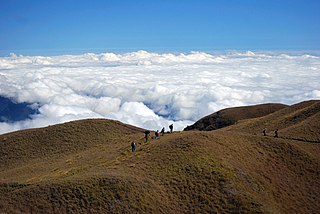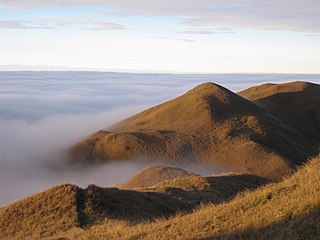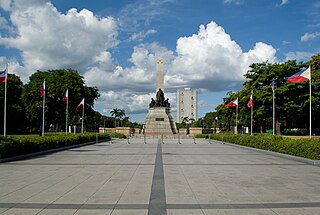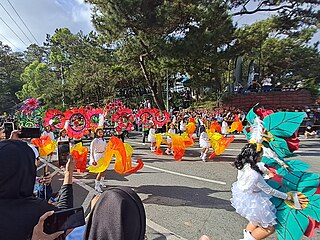
Baguio, officially the City of Baguio, is a 1st class highly urbanized city in the Cordillera Administrative Region, Philippines. It is known as the "Summer Capital of the Philippines", owing to its cool climate since the city is located approximately 4,810 feet above mean sea level, often cited as 1,540 meters in the Luzon tropical pine forests ecoregion, which also makes it conducive for the growth of mossy plants, orchids and pine trees, to which it attributes its other moniker as the "City of Pines".

Benguet, officially the Province of Benguet, is a landlocked province of the Philippines located in the southern tip of the Cordillera Administrative Region in the island of Luzon. Its capital is La Trinidad.

The Cordillera Administrative Region, also known as the Cordillera Region and Cordillera, is an administrative region in the Philippines, situated within the island of Luzon. It is the only landlocked region in the insular country, bordered by the Ilocos Region to the west and southwest, and by the Cagayan Valley Region to the north, east, and southeast. It is the least populous region in the Philippines, with a population less than that of the city of Manila. Baguio is the regional center and largest city.

Mount Pulag is Luzon's highest peak at 2,928 metres (9,606 ft) above sea level, third-highest mountain in the Philippines, and the 26th-highest peak of an island on Earth.

The Ibaloi are an indigenous ethnic group found in Benguet province of the northern Philippines. Ibaloi is derived from i-, a prefix signifying "pertaining to" and badoy or house, together then meaning "people who live in houses". The Ibaloi are one of the indigenous peoples collectively known as Igorot, who live in the Cordillera Central of Luzon.

The indigenous peoples of the Cordillera in northern Luzon, Philippines, often referred to by the exonym Igorot people, or more recently, as the Cordilleran peoples, are an ethnic group composed of nine main ethnolinguistic groups whose domains are in the Cordillera Mountain Range, altogether numbering about 1.8 million people in the early 21st century.

Rizal Park, also known as Luneta Park or simply Luneta, is a historic urban park located in Ermita, Manila. It is considered one of the largest urban parks in the Philippines, covering an area of 58 hectares. The site on where the park is situated was originally known as Bagumbayan during the Spanish colonial period. It is adjacent to the historic Walled City of Intramuros.

La Trinidad, officially the Municipality of La Trinidad, is a 1st class municipality and capital of the province of Benguet, Philippines. According to the 2020 census, it has a population of 137,404 people.

SM City Baguio is the 23rd largest shopping mall in the Philippines. At a floor area of 176,073 m2 (1,895,230 sq ft), it is the largest shopping mall in the North Luzon Region. The entire SM City Baguio complex stands on a land area of 80,000 m2 (860,000 sq ft) on Luneta Hill on top of Session Road overlooking historic Burnham Park and opposite Baguio's City Hall which is situated on a northern hill.

The Panagbenga Festival, also called the Baguio Flower Festival, is a month-long annual flower occasion in Baguio, Philippines. The festival, held in February, was created as a tribute to the city's flowers and as a way to rise from devastation of the 1990 Luzon earthquake. The festival includes floats that are covered mostly with flowers. The festival also includes street dancing, presented by dancers clad in flower-inspired costumes, that is inspired by the Bendian, an Ibaloi dance of celebration that came from the Cordilleras.

The first secondary school in Baguio, Philippines was the normal school in 1916 later called Baguio Trade School. Classes were held where Home Sweet Home now stands as this area and the present University of the Philippines Baguio location was included in the reserved land for the Bureau of Education by Forbes. In 1919 it became Mountain Province High School. Classes were held at Teacher’s Camp and native girls from all over the province were housed at Bua Dormitory known today as Pacdal Elementary School. Among the pioneer teachers were Juan Balagot, Servillano Tumaneng, Pedro Balagot, Genoveva Llamas, Esperanza Ver, Donato Guerzon, Julia Guerzon, Grace H. Miller, Petra Ramirez, and Pilar Tan and Jess L. Gains who was also the principal.

The pasiking is the indigenous basket-backpack found among the various ethno-linguistic groups of Northern Luzon in the Philippines. Pasiking designs have sacred allusions, although most are purely aesthetic. These artifacts, whether handwoven traditionally or with contemporary variations, are considered exemplars of functional basketry in the Philippines and among Filipinos.
Mummification was practiced in the Philippines only on those able to prove the loss of baby teeth. The baby teeth represented youth, losing them illustrated wisdom gained in their mouth. It also portrayed the journey of maturity. Dying without losing baby teeth was a sign of someone who never reached their full potential. Once you lose and grow your first grill, the second time you lose the teeth, it's time to go. That's because they were given a chance of proper dental hygiene. The caves containing the mummies were untouched until the 19th century.

The Baguio Athletic Bowl is a 7-hectare sports complex within the grounds of Burnham Park in Baguio, Philippines. Completed in 1945, it is currently undergoing renovation work.

The Baguio City Heritage Hill and Nature Park is an abandoned structure atop Dominican Hill, Baguio, Philippines. The local government initiated rehabilitation efforts, which was started in April 2022, through a 15 million Philippine pesos grant from the National Commission for Culture and the Arts. The whole property on which it stands has been renamed as the Dominican Heritage Hill and Nature Park. A panoramic view of the city unfolds from its vantage point, the stone crucifix on the outdoor patio of the hotel's second floor.

Mateo Cariño was an Ibaloi chieftain who owned the land that was to become Baguio. He led a successful revolt against the Spanish garrison in La Trinidad and was proclaimed the Capitan Municipal of Baguio by President Emilio Aguinaldo.

The Upper Agno River Basin Resource Reserve is a protected area located on the southeast flank of the Cordillera Central in the Philippine province of Benguet along its border with Ifugao and Nueva Vizcaya. It is a resource reserve located high in the Central and Polis ranges protecting the headwaters of the Agno River. According to section 4 of the National Integrated Protected Areas System Act, a resource reserve is an extensive and relatively isolated area designated as such to preserve the natural resources of the area. The reserve comprises 77,561 hectares of the catchment area that feeds the Ambuklao and Binga dams, two of the country's oldest hydroelectric plants that supply power to the city of Baguio and entire Benguet province. Upper Agno is north of and contiguous with the Lower Agno Watershed Forest Reserve that preserves the immediate downstream of the Binga Dam where the Agno River is impounded by a third dam, the San Roque Dam, the largest in the Philippines and the main source of water, electric energy and irrigation for surrounding regions in Luzon.

Wright Park is a park in Baguio, Philippines.
Sinai Cariño Hamada was a Filipino writer, journalist, and lawyer. He was the founder and editor of the Baguio Midland Courier and The Cordillera Post.

























